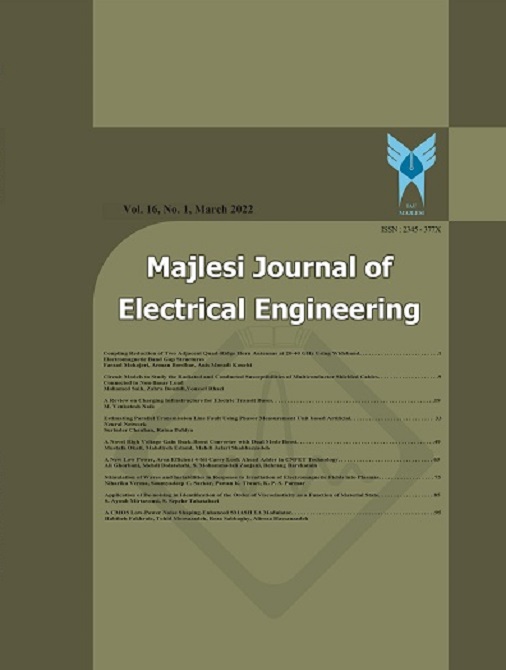[1] N. Amjady, M. R. Ansari “Small Disturbance Voltage Stability Assessment of Power Systems by Modal Analysis and Dynamic Simulation”. Energy Conversion and Management, vol. 49(10), pp. 2629-2641, 2008.
[2] S. Repo, On-line Voltage Stability Assessment of Power Systems-An Approach of Black Box Modeling, Tampere University of Technology Publications 344, 2001.
[3] N. Amjady, M. R. Ansari, “Small disturbance voltage stability evaluation of power systems”, Transmission and Distribution Conference and Exposition, 2008
[4] P. Kundur, J. Paserba, V. Ajjarapu, G. Anderson, A. Bose, C. Canizares, N. Hatziargyriou, D. Hill, A. Stankovic, C. Taylor, T.V. Cutsem, and V. Vittal. “Definition and Classification of Power System Stability”, IEEE Trans. on Power Systems, vol. 19(3), pp. 1387-1401, Aug. 2004.
[5] T. V. Cutsem, C. Vournas, “Voltage Stability of Electric Power Systems”, Kluwer Academic Publishers, Boston, USA, 1998.
[6] F. Zhihong., “The static voltage stability analysis methods for many generators power system–singularity decoupled method”, Proceedings of CSEE., vol. 12(3): pp. 10-18, 1992.
[7] H. Chen., Y. Wang, R. Zhou “Transient and voltage stability enhancement via coordinated excitation and UPFC control”, IEE Proc. Gener Transm Distrib. vol. 148(3), pp. 201-208, 2001.
[8] N. Amjady, M. H. Velayati, “Evaluation of Hopf Bifurcation Considering the Effect of Load Models and Excitation System Parameters”, International Review of Electrical Engineering, vol. 6(5), pp. 2419-2427, 2011.
[9] N. Amjady, M. H. Velayati, “Evaluation of the Maximum Loadability Point of Power Systems Considering the Effect of Static Load Models”, Energy Conversion and Management, vol. 50(12), pp. 3202-3210, 2009.
[10] GM. Huang, L. Zhao, X. Song, “new bifurcation analysis for power system dynamic voltage stability studies”, In: Proc. IEEE power eng. Soc. winter meeting. 2002, pp. 882-887, 2002.
[11] J. Hongjie., Y. Xiaodan, Y. Yixin, “An improved voltage stability index and its application”, Electrical power and energy systems, vol. 27, pp. 567-574, 2005.
[12] A. P. Lerm, “Control of Hopf Bifurcation in Multi Area Power Systems via a Secondary Voltage. Regulation Scheme”. IEEE Trans. Power Syst., vol. 23(3), pp. 245-254, 2002.
[13] C. F. Yang, G. G. Lai, C. H. Lee, C. T. Su, G. W. Chang, “Optimal Setting of Reactive Compensation Devices with an Improved Voltage Stability Index for Voltage Stability Enhancement”. Electrical Power and Energy Systems, vol. 37(1). pp. 50-57, 2012.
[14] H. Raoufi, M. Kalantar, “Reactive Power Rescheduling with Generator Ranking for Voltage Stability Improvement”. Energy Conversion and Management, vol. 50(4), pp. 1129-1135, 2009.
[15] A. Kargarian, M. Raoofat, M. Mohammadi, “Reactive Power Market Management Considering Voltage Control Area Reserve and System Security”, Applied Energy, vol. 88(11), pp. 3832-3840, 2011.
[16] N. Amjady, M. Esmaili, “Improving voltage security assessment and ranking vulnerable bus with consideration of power system limits,” Elect. Power Energy Syst., vol. 25(9), pp. 705–715, Nov. 2003.
[17] H. Chen, Y. Wang, R. Zhou, “Transient and voltage stability enhancement via coordinated excitation and UPFC control,” IEE Proc. Gener. Transm. Distrib., vol. 148(3), pp. 201-208, May 2001.
[18] R. J. Avalos, C. Canizares, F. Milano, A. j. Conejo, “Equivalency of Continuation and Optimization Methods to Determine Saddle-node and Limit-induced Bifurcations in Power Systems”. IEEE Trans. Circuits and Systems–I: Regular Paper., vol. 56(1), pp. 210-223, 2009.
[19] P. W. Sauer and M. A. Pai, Power System Dynamics and Stability, Upper Saddle River, NJ: Prentice-Hall, 1998.
[20] W. Marszalek, Z. W. Trzaska, “Singularity-Induced Bifurcations in Electrical Power Systems,” IEEE Trans. on Power Systems, vol. 20(1), pp. 312-320, Feb. 2005.
[21] N. Amjady, “Dynamic voltage security assessment by a neural network based method,” Elect. Power Syst. Res., vol. 66(3), pp. 215–226, Sep. 2003.
[22] K. Hongesombut, Y. Mitani, and K. Tsuji, “Power System Stabilizer Tuning in Multimachine Power System Based on a Minimum Phase Control Loop Method and Genetic Algorithm”, 14th PSCC, Sevilla, pp. 1-7, June 2002.
[23] M. A. Pai, Energy Function Analysis for Power System Stability, Kluwer, Boston, 1989.
[24] http://www.ee.washington.edu/research/pstca/.
[25] DIgSILENT User Manual Toolbox, Available: http:// www.digsilent.de/.
[26] H. K. Nam, Y. K. Kim, K. S. Shim, and K. Y. Lee, “A new Eigen-sensitivity theory of augmented matrix and its applications to power system stability analysis,” IEEE Trans. Power Syst., vol. 15(1), pp. 363–369, Feb. 2000

